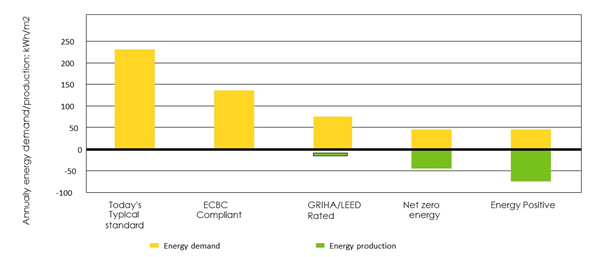 Mr Sanjay Seth
Mr Sanjay Seth
Energy Economist
Bureau of Energy Efficiency
Sanjay Seth is an Energy Economist with the Bureau of Energy Efficiency, Ministry of Power, Government of India. In this role, he is responsible for the promotion and implementation of the Energy Conservation Building Code and improving Energy Efficiency in existing buildings through retrofits.
By training he is an Engineer and has more than twenty five years of experience in the power sector of which seven years have been on the Demand Side. Prior to joining the Bureau, he has worked in various capacities in a Central Public Sector Generating company, under the Ministry of Power and was associated with planning, monitoring, co-ordination and construction management of Hydro and Thermal power projects.
Energy Conservation Building Code:
Using the code to achieve energy efficiency in NZEBs
Fundamentals of net zero energy buildings underline the primacy of energy efficiency. Achieving efficiency of energy use in a building is the foremost target in getting to energy neutrality.
Adopting energy conservation measures specified in Energy Conservation Building Code (ECBC) of India offers a simple approach to achieve minimum energy efficiency in NZEBs. Minimum efficiency dictated by ECBC can be the baseline of energy usage in NZEBs.
ECBC was launched in 2007 for commercial buildings. Compliance with the code is currently voluntary, exceptions being government buildings in certain states. From 2017 onwards, the code will be mandatory for all commercial buildings across the country.
Guaranteed enhanced energy performance
Codes sets benchmarks for energy performance that should be achieved by compliant buildings over their typical counterparts. ECBC compliant building is designed to be 25% to 30% more efficient than a corresponding conventional prototype building.
Energy use intensity (EUI) of a typical building in India is nearly 225 kWh/ square meter/ year. EUI of ECBC compliant building is around 140 kWh/ square meter/ year. The few NZEBs that have been constructed in India have an EUI of about 50 kWh/ square meter/ year.
Designers and owners would thus know the level of efficiency in a compliant building and can then explore other methods and technologies to increment the energy performance for NZEBs.
Wide scope for application
ECBC is expansive in its scope and application. The code covers all commercial buildings with connected load of 500 Kw and contract demand of 600 kVA or more. Both 12 and 24 hour occupancies are covered by the code. Design and system requirements for all the climatic zones of India are covered.
The code addresses energy efficiency in building envelope, lighting systems, HVAC, and, electrical and renewable energy systems. Natural ventilation and access to daylight are essential to demonstrate compliance with ECBC.
Advanced energy efficient technologies
ECBC is undergoing a technical update currently with the objective of including advances that have been achieved in building materials and systems technologies since 2007 in the code. The updated code will prefer technologies and materials that are more efficient across their lifetimes and offer faster paybacks on investment.
Bureau of Energy Efficiency is also developing an ECBC Empanelment Program for professionals to build a cadre of qualified and skilled designers, engineers and enforcement officials who can ensure compliance with the code once it is made mandatory. For builders and building owners who are striving to construct NZEBs, this program will provide much needed access to a technically competent workforce for designing high performance buildings.
Architects and engineers who recognize the potential of ECBC to be a stepping stone to NZEBs will find it a useful tool in realizing energy efficiency in NZEBs.
Disclaimer: Reference in this Web site to any specific commercial products, processes, or services, or the use of any trade, firm or corporation name is for the information and convenience of the site’s visitor’s, and does not constitute endorsement, recommendation, or favoring by the Ministry of Power, Government of India, or Bureau of Energy Efficiency, Ministry of Power, Government of India. Additionally, the views and opinions of authors expressed herein do not necessarily state or reflect those of the Ministry of Power, Government of India, or Bureau of Energy Efficiency, Ministry of Power, Government of India, and shall not be used for advertising or product endorsement purposes.

